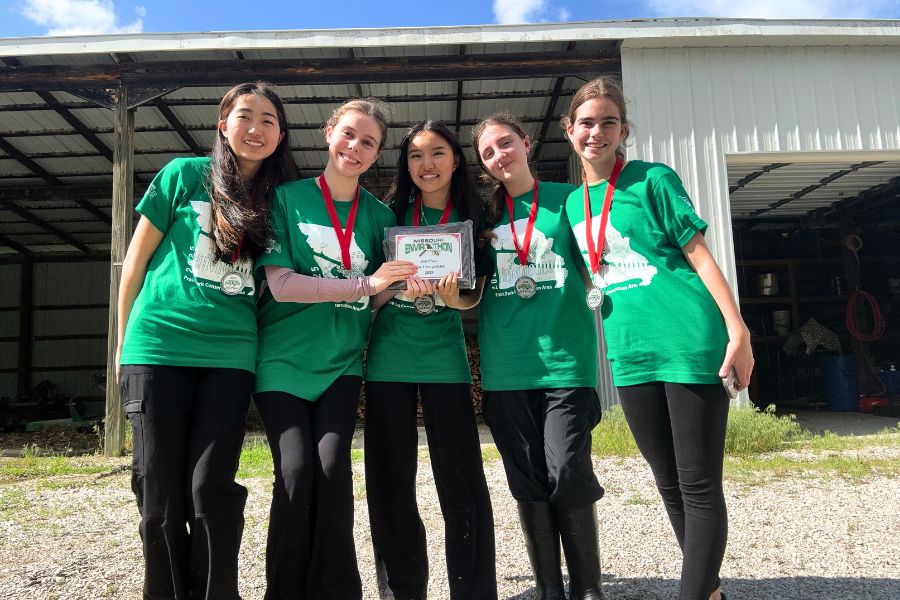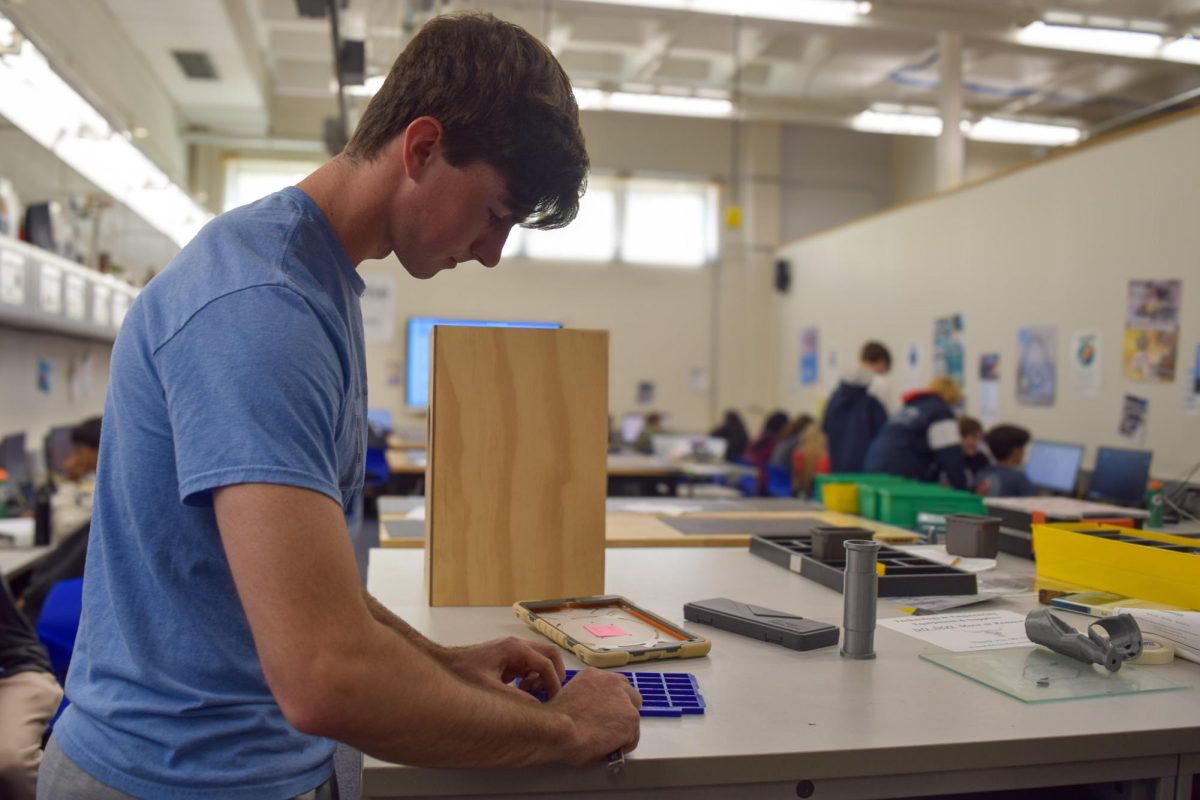A coming crisis
Humanity’s age-old fight against bacterial disease has come with successes and setbacks. The advent of antibiotics, starting with penicillin, struck a vital blow for the forces of sapience, but those gains are now at risk. The wide use of antibiotics and pharmaceutical waste dumping have contributed to the development of antimicrobial-resistant bacteria that can survive antibiotic treatment. Senior Rio Naghibi Harat has contributed to a solution: phage therapy, the use of bacteriophage that feed on infectious microbes to treat illness.
“[Phage] can evolve. Antibiotics can’t; they’re one solid molecule. They cause resistance because people won’t finish their prescriptions. Bacteria get stronger, they learn how to fight [the medicine], and then you’ve got a strain of bacteria that is resistant to this particular drug. Phage won’t do that because they will evolve with the bacteria,” Naghibi Harat said.
Eventually, antimicrobial-resistant bacteria could cause millions of deaths. Phage therapy has the potential to prevent that. Bacteria struggle to develop resistance to both antibiotic and phage treatments, which creates an opportunity for more effective and sustainable treatment.
“People are trying to bring back phage therapy because there are a lot of antibiotic-resistant bacteria, including tuberculosis, which is the one I’m working on,” Naghibi Harat said. “The more that we let them grow on their own, the worse it’s going to get, so we are hoping that people will turn to phage therapy.”
A rare responsibility
Through Webster University, Naghibi Harat has been developing phage to explore this potential. The Pittsburgh Phage Program at the University of Pittsburgh requested the research as a part of a deep dive into the potential of bacteriophage.
“My parents are in medicine, and we have a bunch of family friends [who] are in medicine,” Naghibi Harat said. “I was talking to one of them, telling her that I was interested in research, and she [said], ‘I know somebody at Webster who’s been meaning to get this one project done.’ One thing led to another, and they [said], ‘We can get you in the lab.’ The professor worked with me one-on-one for two weeks and then let me run loose.”
The program entrusted Naghibi Harat with a significant amount of responsibility for the research. They completed their work alone and without recourse to assistance; it was Naghibi Harat’s project and no one else’s.
“The only other person that I ever saw in another lab was working on genetic transformation. They were working with Agrobacterium, a completely separate thing from what I was doing. I just came in with my bacteria, no one else was really in the lab. The building is really big, so it was hard to find people,” Naghibi Harat said.
Being entrusted with such an important project put Naghibi Harat under pressure. In a high school setting, messing up an experiment comes with few consequences. In phage development, a lab worker can set back crucial research.
“It was a lot of separating out my variables and trying to figure out what was what. Honestly, it was fun, but I was nervous. [I wondered] if all of [the variables] were the problem, what [would happen] if it didn’t work? It was nerve-wracking,” Naghibi Harat said.
A fulfilling challenge
The high degree of autonomy granted to Naghibi Harat belies the difficulty of the experiment. The operation was so complex that they even needed to research in order to be able to start their research.
“The first thing I had to do [was] to figure out what kind of bacteria I needed to use,” Naghibi Harat said. “I used NIH.gov and looked through different types of bacteria. I would check their specific genetic sequences, which are called orthologs, against tuberculosis to find the best match, and that’s how I decided which one to use. From there, I had to look up different mediums and different proteins. I ran a lot of tests trying to figure out what would stay in, grow the bacteria and cling to the phage.”
Because they were creating research instead of reproducing it, Naghibi Harat couldn’t foresee every twist and turn in the process. That forced them to adapt if and when problems arose.
“I had a path that I was following, but I [had] to deviate from it because some things weren’t working,” Naghibi Harat said. “One of the types of peptone, which is a protein that I use to grow the bacteria, [moved] all of the calcium. That precipitated out, and phage need the calcium to actually be able to bind to the bacteria. And so when I had plated that, I didn’t realize that all the calcium was precipitating out until I pulled out the tray and there [were] two growths. That sent me into a panic. I didn’t know if the problem was with my phage, with my peptone, or with my bacteria. So, I had to set up an entire experiment separate from what I was already doing to figure out the problem. It turned out to be the peptone. And then I was able to redo the initial growth process.”
The research was an opportunity for Naghibi Harat to apply the learning that they have refined over the past few years. Their work required ample background knowledge, problem-solving ability and resilience. The result, though, was a challenge met and conquered.
“I needed to find a bacteria that was close enough to tuberculosis (TB) because I’m not allowed to use it,” Naghibi Harat said. “The bacteria I used was mycobacterium smegmatis, which is very harmless compared to TB, and I felt safer using that; I don’t want to make [an] incident. I was growing the phage against the [bacteria] so that it could read TB. It did actually end up working, which was epic for me.”
Naghibi Harat intends to major in nursing at the University of Missouri. After completing this project, further phage research remains in their future plans.
“I definitely think [I’ll continue this],” Naghibi Harat said. “Having this experiment actually matter and not be [in] a high school setting, [where] you have a safety net, made me really think about all the possibilities that could arise from this issue. [I wondered], how can I [fight] against it?”

![Phage grown by senior Rio Naghibi Harat sit in petri dishes. Through Webster University, Naghibi Harat was given the opportunity to develop phage as a potential remedy for tuberculosis. “Phage are everywhere. I got mine from a soil sample. I'm not kidding; I picked [it] up from dirt. They're harmless, unless you code them to do something, and they can evolve. Virus antibiotics can't. They're one solid molecule. A strain of this bacteria [can evolve] that is resistant to [a] particular drug, [but] phage will evolve with the bacteria. They can see the changes, and they can be the change,” Naghibi Harat said.](https://pwestpathfinder.com/wp-content/uploads/2025/04/Flag-2.png)

![Focused on providing exceptional service, sophomore Darsh Mahapatra carefully cleans the door of a customer’s car. Mahapatra has always believed his customers deserve nothing less than the best. “[If] they’re trusting us with their car and our service, then I am convinced that they deserve our 100 percent effort and beyond,” Mahapatra said.](https://pwestpathfinder.com/wp-content/uploads/2025/10/DSC_0018-1200x800.jpg)
![Sophomore Aleix Pi de Cabanyes Navarro (left) finishes up a soccer game while junior Ava Muench (right) warms up for cross country practice. The two came to Parkway West High School as exchange students for the 2025-2026 school year. “The goal for the [exchange] program is to provide opportunities for both Parkway students and our international exchange students to learn about other cultures, build connections and become confident, capable, curious and caring — Parkway’s Four C’s — in the process,” Exchange Program Lead Lauren Farrelly said.](https://pwestpathfinder.com/wp-content/uploads/2025/10/Feature-Photo-1200x800.png)

![Gazing across the stage, sophomore Alexis Monteleone performs in the school theater. The Monteleone family’s band “Monte and the Machine” has been releasing music since 2012, but Alexis started her own solo career in 2024 with the release of her first single, Crying Skies. “My whole family is very musical, [and I especially] love writing [songs with them],” Monteleone said.](https://pwestpathfinder.com/wp-content/uploads/2025/09/DSC7463-1200x798.jpg)
![Amid teaching a lesson to her AP Calculus BC class, Kristin Judd jokes alongside her students in their funny remarks. Judd has always enjoyed keeping the mood light in her classroom, along with on the volleyball court. “[I enjoy] that side talk where you see [or] overhear a conversation and chime in, or somebody says something funny,” Judd said.](https://pwestpathfinder.com/wp-content/uploads/2025/09/image-1200x730.jpg)
![Eyeing the ball, junior Ella McNeal poses for her commitment pictures at Clemson University. McNeal’s commitment comes after months of contact with top Division 1 soccer programs. “ It has taken a lot to get to where I am, but I know that [what] I've already been through is just the beginning, and I can't wait for what is to come,” McNeal said.](https://pwestpathfinder.com/wp-content/uploads/2025/09/IMG_4926-1200x900.jpeg)


![Senior Adam Zerega stands with senior Dexter Brooks by farm equipment. Zerega often worked with friends and family on his farm. “I've been able to go to my family's farm since I was born. I [spend] at least three weekends a month [on the farm], so I'm there all the time,” Zerega said.](https://pwestpathfinder.com/wp-content/uploads/2025/04/IMG_4872-1200x900.jpg)

